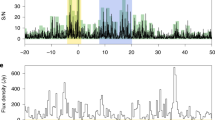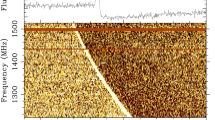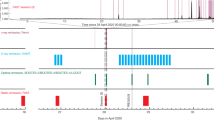Abstract
JUPITER emits highly sporadic and intense radio emission in the 0.45–40 MHz frequency range1. Several high-resolution observations below 28 MHz have revealed that a significant fraction of this radiation, perhaps 25%, is comprised of S bursts, which are characterised by rapid negative drift rates R (tens of MHz s−1) and extremely narrow instantaneous band-widths (≤200 kHz2–7. The probability of observing S bursts, which are associated exclusively with source regions B and C, is determined to a large extent by the geocentric phase of Io. This has led to the widely-held conclusion that the emission is beamed from the planet's Io-associated magnetic flux tube (IFT). S-burst emission models generally assume simple adiabatic motion of trapped electrons accelerated at Io and radiating at or close to the local electron gyrofrequency (refs 8–10). The details of the emission process are unclear and at present offer no restrictions as to the sign of R; however, as the S bursts exhibit negative frequency drift (R<0), we shall speak only in terms of electron bunches radiating as they stream outward from their mirror point near the IFT foot. In this context |R| is predicted to increase rapidly from zero to some maximum value (depending upon electron energy) as the particles execute this motion. In terms of frequency, this region of the northern hemisphere IFT corresponds to fg ≳ 27 MHz. A determination of R at several points in this frequency range is then a critical test of models incorporating a trapped-electron hypothesis. Accordingly, we present here a preliminary report on observations conducted in this range.
Similar content being viewed by others
References
Carr, T. D. & Desch, M. D. in Jupiter (ed. Gehrels, T.) 693–737 (University of Arizona, Arizona 1976).
Gordon, M. A. & Warwick, J. W. Astrophys. J. 148, 511–533 (1967).
Ellis, G. R. A. Nature 253, 415–417 (1975).
Riihimaa, J. J. Astr. Astrophys. 39, 69–70 (1975).
Groth, M. J. & Dowden, R. L. Nature 255, 382–384 (1975).
Krausche, D. S., Flagg, R. S., Lebo, G. R. & Smith, A. G. Icarus 29, 463–475 (1976).
Riihimaa, J. J. Astrophys. Space Sci. (in the press).
Ellis, G. R. A. Radio Sci. 69D, 1513–1530 (1965).
Goldreich, P. & Lynden-Bell, D. Astrophys. J. 156, 59–78 (1969).
Kawamura, K. & Suzuki, I. Astrophys. Lett. 18, 19–23 (1976).
Smith, E. J., Davis, L. Jr & Jones, D. E. in Jupiter (ed. Gehrels, T.) 788–829 (University of Arizona, Arizona, 1976).
Piddington, J. H. Cosmic Electrodynamics 3, 240–253 (1972).
Shelley, E. G., Sharp, R. D. & Johnson, R. G. Geophys. res. Lett. 3, 654–656 (1976).
Flagg, R. S., Krausche, D. S. & Lebo, G. R. Icarus 29, 477–482 (1976).
Author information
Authors and Affiliations
Rights and permissions
About this article
Cite this article
DESCH, M., FLAGG, R. & MAY, J. Jovian S-burst observations at 32 MHz. Nature 272, 38–40 (1978). https://doi.org/10.1038/272038a0
Received:
Accepted:
Issue Date:
DOI: https://doi.org/10.1038/272038a0
- Springer Nature Limited
This article is cited by
-
Short-lived Jovian decametric events observed with an acousto-optical radio spectrograph
Earth, Moon, and Planets (1987)
-
A theory of Jovian shadow bursts
Earth, Moon, and Planets (1986)
-
Interaction of S- and L-bursts in Jupiter's decametric radio spectra
The Moon and the Planets (1981)
-
The source of the Jupiter S-bursts
Nature (1980)
-
Drift rates of Jupiter's S-bursts
Nature (1979)





